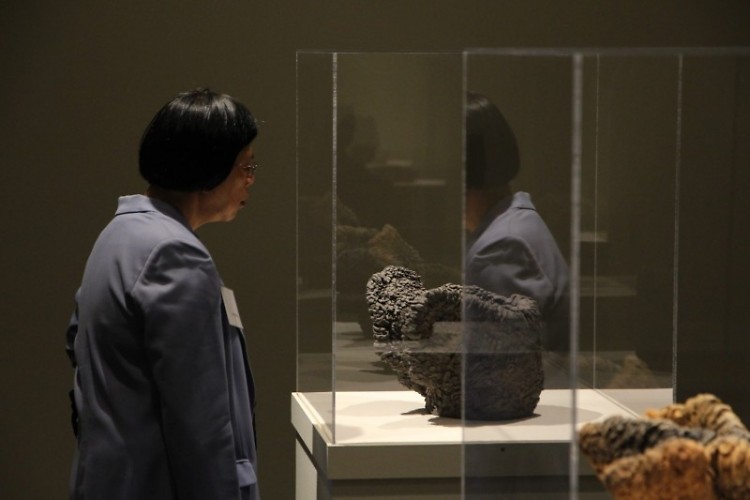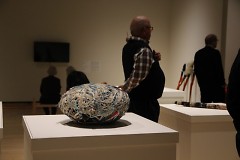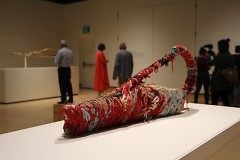DisArt has been a growing organization in the Grand Rapids area, hosting a number of events to share, promote and celebrate the artistic work of people with disabilities throughout the world. These events include exhibits, conferences and shows, most of which coincide with ArtPrize. As the art exhibited at these past events was the kind that is experienced primarily in a visual way, such as paintings and sculptures, an idea was proposed to include tactile or auditory art so that anyone and everyone could participate in or experience this organization's future projects.
After hearing about DisArt through both personal and public sources, I reached out to one of the organization's cofounders, Jill Vyn. I expressed my ideas about including auditory and/or tactile art in any of DisArt's future projects, as the inclusion of these art forms could hopefully increase participation in and experience of these events, especially in regards to certain disability communities that had been rarely showcased or represented in DisArt's past projects.
We discussed what kinds of things we could do to include these art forms in upcoming exhibitions and the events related to and coinciding with them. One of these ideas was to have the exhibits feature audio descriptions of the pieces as well as musical images that describe the art in a creative way; we made it a goal to include both of these features in the then-upcoming exhibit, "Process and Presence."
It was decided that each musical piece would be an auditory representation of the style of a work or artist while also having a background-like quality, enough to give the art a new dimension while not distracting people from the art pieces themselves. In doing this, the music would capture the elements of the art pieces, containing matching elements like layering, texture, dimensions, material, and even the process of creating the art as well as any objects the art represented.
For example, if there is a bumpy sculpture, the musical image would contain a sound reminiscent of an object going across a rough surface, which would be an audio equivalent of the sculpture's bumpy texture. Additionally, with many of the art pieces in "Process and Presence" having an abstract nature, the music would reflect this quality by using sounds that wouldn't immediately conjure up real instruments or objects. With all of this in mind, I was ready to start getting plans in place to make these ideas a reality.
After deciding that this project would be a good fit for not only the exhibit itself, but also for the mission of DisArt, a team was established to carry out this effort in a timely yet effective and fun manner. Along with the two cofounders of DisArt, Chris Smit and Jill Vyn, the team included Zoe Pentaleri, a volunteer who would look at and write descriptions for each piece of art, and two young blind musicians, Tyler Zahnke and myself.
I specifically recruited Tyler out of my many blind musical friends, as he and I share the same passion for promoting the creativity of people with disabilities as well as the love of expressing such creativity through music. Like the project itself, the specific members of the team represent DisArt's mission, especially given that the music is created by members of the blindness community, a specific disability group which hadn't been represented that frequently if at all in DisArt's past projects. Once some descriptions were sent out to all the members of the team, music tracks were assembled accordingly depending on what was included in the text description, such as a sculpture's material, shape, texture and complexity. Tyler and I would read the text descriptions and decide which elements of the art could be represented by which types of sounds. We would fit these sounds into innovative music loops and send them back to the rest of the team for all of us to listen to and review together.
Going along with the mission and purpose of DisArt, I am fairly certain that the addition of both audio descriptions and music tracks will open up the exhibit to a wide variety of people. Visitors to the exhibit, whether online or at Meijer Gardens, will be able to not only look at the art but experience the art in a different and unique way and appreciate the effort that went into this aspect of the exhibit as well as the main art itself.
Like the DisArt exhibits in the past, "Process and Presence" will be displayed at the Frederik Meijer Gardens starting in September, with a fashion show and conference also happening this Fall. Feel free to check out some of the art pieces and their musical equivalents at this site.
The Rapidian, a program of the 501(c)3 nonprofit Community Media Center, relies on the community’s support to help cover the cost of training reporters and publishing content.
We need your help.
If each of our readers and content creators who values this community platform help support its creation and maintenance, The Rapidian can continue to educate and facilitate a conversation around issues for years to come.
Please support The Rapidian and make a contribution today.



